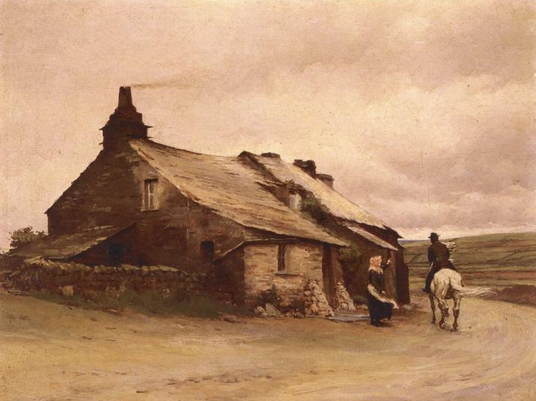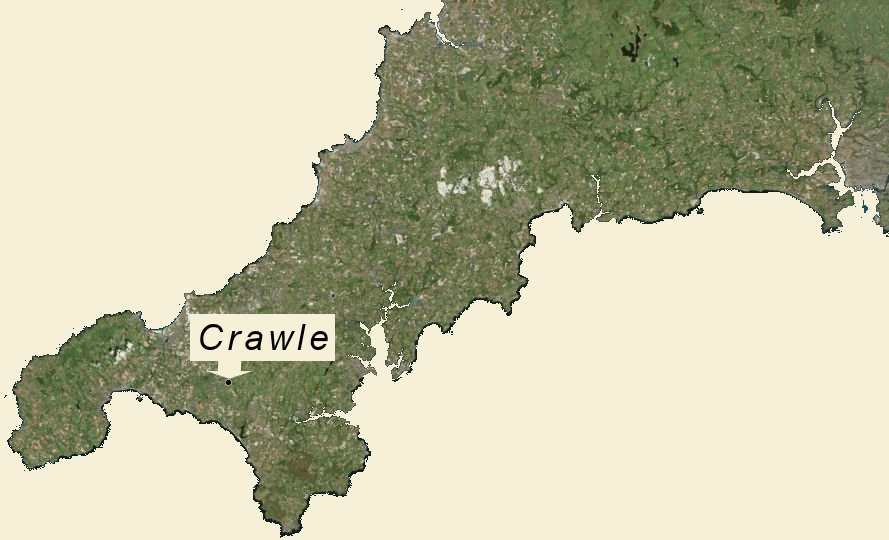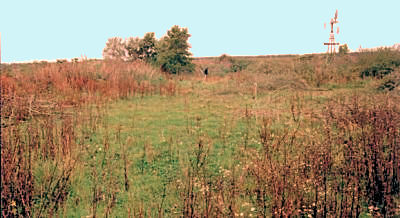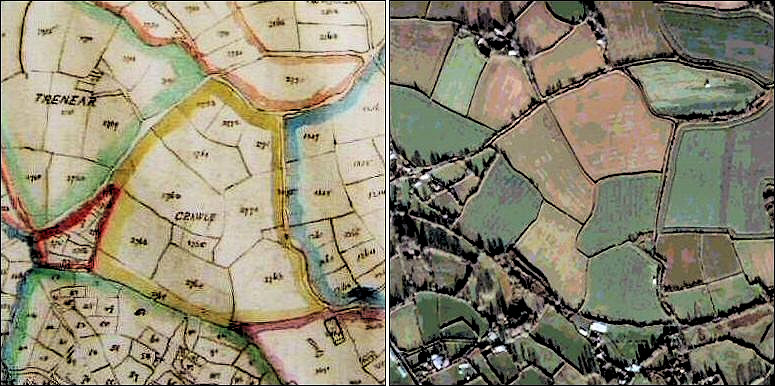Crawle - Crohall - Cariohall
Introduction
Crohall is mentioned in the early parts of the Ripper family history as the home of one branch of the family from the mid 1500s to around 1700. The buildings of Crawle have since disappeared. There had been buildings on this site for many years as can be seen by the number of people documented to have lived here over the years. At its highest, the population of Crawle appears to have been about 32.

A Lone Cottage In Cornwall
by Anna Mary Richards Brewster
The landowner I met in 1994, Willie Goldsworthy, remembers the building as a small single level one roomed farmer's dwelling (perhaps similar to half of the cottage shown in this image) with two additional out houses - a cow shed and a barn. Willie recalls seeing the buildings around 1935, but the buildings had gone by 1944 as the result of a fire. He recalled them as being of cob construction, mud & dung & straw etc, and the roof level of the single floor building as being very low. It seems there are no plans to do anything with this now derelict piece of land.
Crawle has not been shown on maps since the late 1800s and at that time was shown as Crawle, having been recorded in the Domesday Book in 1086 as Cariahoil. The name is derived from 'caer' meaning "camp" and 'iorchell' meaning "roebuck". Later spellings can be seen at the top of this page.
The deerpark as an entity was probably created by Sir Alexander Godolghan around 1300, the deerpark and warren were symbols of his wealth and affluence. The deerpark encompassed most of the hill and the fields that ran down to the manor, as well as a large tract of land on the northern side of the hill reaching as far as the River Hayle. The entire area was surrounded by a deep ditch and a high hedge known as a deer pale, constructed to allow deer on the outside to jump in, but made it difficult for deer on the inside to jump out. A large part of the deer pale is still intact today.
Remnants of the deer herd lingered on until the mid-19th century. Hounds chased one almost to Camborne, where it dropped dead from exhaustion. A second was shot at nearby Crawle. The third and last deer was trapped at Carsluick, where the farmer had become so incensed by the animal ravaging his crops that he set a trap made from an upturned harrow in a pit. When the animal jumped over the hedge, it became impaled and the farmer then secretly butchered the deer.
In mediaeval times, rabbits were imported from the Mediterranean and accommodation was provided for them in the form of pillow mounds. These were earth mounds with small stone chambers inside where the rabbits could shelter from the wet and cold. Rabbit meat was considered a great delicacy and to possess a colony was a sign of affluence.
Location
Crawle was a tenement to the north of the parish of Breage in the west of Cornwall. To the west of Crawle is Tregonning Hill which overlooks Mounts Bay and offers a vantage point for Penzance, St Michael's Mount, the village of Breage and The Lizard Peninsula. From the top of Tregonning Hill can be seen the seas to the north, the west and the south of Cornwall.
The site of Crawle can be seen on modern Ordnance Survey maps as the site of a windpump just north of Polladras. Click on the link and change the layer from "Road" to "Ordnance Survey".

Crawle
photo taken 1994
The extent of the built part of the site can still be identified as field boundaries and small remains of low walls amidst nettles and brambles. The wind pump draws water which is pumped uphill to a feeder tank which supplies clean fresh water to Trenear farm.
Trenear is marked on Ordnance Survey maps at location SW617313, four miles to the North West of Helston, Cornwall. Crawle is best approached from Godolphin Cross, taking the eastbound road from the crossroads in the centre of the village.
The road drops down to Ruthdower Cottage and then rises up the hill past Trenear Farm entrance on the left. A few hundred yards further on, again on the left, is the entrance to Treleggo farm. Immediately past this on the opposite side of the road is the northern end of a lane leading towards Polladras, called Crohall Lane in 1647.
Turning into Crohall Lane, the second field boundary on the right hand side comes just before a gate. At this boundary an east-west path crosses the road, and emerges on the west side of the road through the farm gate. On the southern edge of this field is the aforementioned Polladras. It is possible to walk down to Polladras and follow the field boundary westwards to a gap just beyond the limit of Crawle. The boundary then continues back to the lane, about 50 yards further downhill on Crohall Lane and emerges through another gate.
Between this gate and the gate further up the hill, which is the path entrance, there exists another gate which is the entrance to Crawle. The whole plot is triangular, roughly equilateral, the 30 yard stretch on Crohall Lane forming its eastern boundary. The western point of the triangle looks towards Tregonning Hill on the skyline. Just a couple of fields to the west of Crawle can be seen the remains of the engine house of Polrose Mine.
Crawle in History
Until 1396 Crawle was part of the manor of Carminow but the last heiress of the line, Joan Carminow, died and the estate was divided up. The Arundell family took ownership of the manor and by the early years of the 16th century the manor had been reduced in size and Crawle became part of the manor of Pengwedna. During this period of transition the land was part of a chantry endowment. Jurisdiction over the manor was exercised through manor courts. Mr H L Douch who was until the mid 1990s the curator of the The Courtney Library, reports that the manor court of Pengwedna was sometimes held at Cariohall but more often at Prospidneck in neighbouring Sithney, probably for convenience.
Pengwedna is described as follows by Mr Douch:
"this name must be taken with Gwedna in the same area. Gwedna is on a hillside between two arms of the Upper Hayle river. Pengwedna is a good mile away at the top of a small valley. There is not much that the two places have in common but possibly Gwedna was the name of the head streams of the River Hayle."
The map below shows the tenement of Crawle, edged in yellow, as recorded on the 1786 estate map and alongside it a modern day aerial image.
 Crawle Tenement |
The residential and farm buildings which form part of the tenement are shown in the small triangular plot on the eastern boundary. Careful comparison of the two images reveals the original field boundaries, many of which still exist as hedges and walls but some remain as subtle changes in the colouring of crops.
As the family lived at Crawle and the Tin Musters Roll of 1535 shows William Carwall, this may be the earliest indication of the family in Breage; it was not uncommon for people in Breage to be known by their place of residence interchangeably with their surname. The earliest confirmed reference I have to date of a connection between Crawle and the Ripper family is the burial of Joan Rypper of Cariurrall at Breage on 13 November 1561.
 1561 burial of Joan Rypper of Carriurrall |
Mr Douch has informed me that there was a lease of Cariohall which was granted to William Ripper and John Ripper on 16 January 1577. William and John were, almost certainly, brothers.
On 24 October 1586 the court rolls show that John & William Ripper surrendered the lease on the tenement in Cariohall, effectively removing William who became free to take the tenancy of Ruthdower Mill, and a new lease was granted to John Ripper, his son John Ripper and Constance Squire, the daughter of Richard Squire, deceased. At this time it was usual for a lease to be agreed for the period of "three lives". In this instance the lives were John, John and Constance and the lease would run until the last of the three died. It was not unusual for one of the lives to have been a child, but no child formed part of the family group at this time.
On 28 January 1606/7 the Breage registers record the baptism of Stephen Ripper, son of John Ripper alias Craholl.
 The baptism of Stephen Ripper |
Later Generations Living at Crawle
A list of tenants in 1640 shows the name of Thomas Ripper, but this has been crossed out, usually an indication of the lease having passed to the next life. In fact the will of Thomas wasn't written until 1661. Indeed on 9 Oct 1640 Thomas Ripper and John Symon were nominated viewers of repairs by the court.
Further, on 30 September 1641 Thomas Ripper was presented to the court as a viewer of repairs and customary tenant, because he had not fulfilled his duties as viewer. In May 1642 he was again called before the court for non-attendance to his duties. In 1642 he was appointed reeve of the manor, in respect of his holding at Crohall. It seems that he didn't qualify on the grounds of application to duty, but then on 16th April 1644 he and John Simon were once again chosen as viewers of repairs.
On 30 July 1647 the court was held at Crohall again, Mr Douch reports the following entry in the court record:
"whereas there is a difference betwene Thomas Ripper, John Andrew, William Tremellinge and Jane Lanyon (widow) concerninge the pasture of one crought [croft] adjoining with Crohall Lane end, and whereas the saith Thomas Ripper hath now att this present beaten up parte of the said crought and doeth pritend to till the same, which is denyed by the said John, William and Jane, and is by them for the said tillage reserved unto mee, I doe therefore order that the said Thomas shall quietly (if hee please) till the same for two yeares and to paye yearely unto them the said John, William and Jane 6d, and farther to leave the said parcell of land in common as was before itt was att the end of two yeares. If the said Thomas shall make it appeere or prove that the said crought doeth solely belonge unto him that then they shall utterly disclayme the same and leave itt quietly and peaseably without any shere disturbance unto him the said Thomas ever hereafter."
Note: In the 1666 poll tax returns the Andrew family lived at Treneere whilst at Tremelling lived the Treligo family.
26 September 1647 - Thomas Ripper and William Tremellin were appointed as viewers
26 September 1648 - Thomas Ripper was appointed reeve of the manor
28 March 1657 - Thomas Ripper (69) (mort), English (his wife) (mort) and Edward (their son) (35) are listed in the Arundel Papers as tenants of Cariohall in the manor of Pengwedna - it is probable that the indication (mort) means that these are the lives mentioned in the lease.
Thomas died in 1661 and was probably buried in Breage churchyard but no entry of this has been found. He did, however leave his last will and testament which was later the subject of some contention.
The 1660 poll tax shows that living at Crohall were Edward Ripper and his wife, who were taxed one shilling, and also Daniel Ripper, also taxed one shilling.
In the 1664 Hearth Tax assessments the property was occupied by Edward and Blanch Ripper, who were assessed as having four hearths (one of which had been stopped up) and Daniel and Elizabeth Ripper, who had one hearth. This seems to indicate that there were two properties at Crawle. The fact that the courts had been held there also indicates that there had been a substantial property on the site.
The Breage registers record the baptism of Ann the daughter of Hennerye Ripper & Jane, of Crohall, on 11th January 1665. Their second daughter, Jane, is recorded in Breage register as being baptised on 1st November 1668.
On the 17th April 1672 Edward Ripper is recorded as being among customary and conventionary tenants and on 23rd October 1672 Edward Riper was chosen as Reeve in respect of his tenement called Crohall.
On the 5th April 1673 the manorial court was held at Crohall.
According to the IGI, on the 7th January 1694 the Breage registers show the baptism of Maria Crohall or Repper, the daughter of Mari Crohall or Repper. Having researched the registers I have been unable to verify this entry.
The lease of Cariohall, described as being in the tenure of Blanch Ripper, widow, was granted on 1st March 1700 to Nicholas Tyacke, Gentleman. The term of the lease was 99 years on the lives of Nicholas Tyacke and his wife after the expiry of Blanch Ripper's interest, indicating an earlier lease of Cariohall to the Ripper family. Blanch died in 1703 and was buried on 30th July at Breage.
In 1712 on the 21st of May at Breage was buried William Ripper alias Crohall, and on 13th September a Richard Ripper alias Crohall was also buried. This may indicate that they continued to live there as the tenants of Nicholas Tyacke.
There are no further entries yet traced to show any continued occupation of Crawle by the Ripper / Repper family which had lasted for almost 200 years.